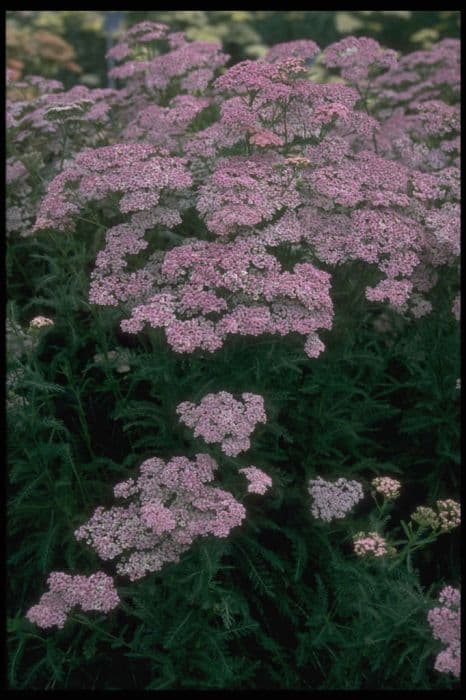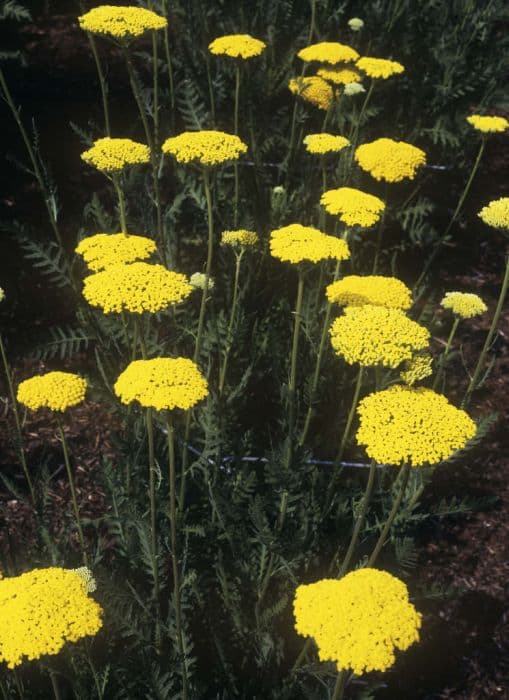Plains Coreopsis Coreopsis tinctoria 'Mardi Gras'

ABOUT
Coreopsis tinctoria 'Mardi Gras', commonly known as Plains Coreopsis or Tickseed, is an ornamental plant celebrated for its vibrant and cheerful flower display. This particular cultivar is notable for its striking flowers which feature a captivating color palette. Each blossom is characterized by a central disc typically dark in color, often a deep maroon or chocolate hue, which is surrounded by a fringe of ray florets. These outer petals are the standout of the display, showcasing a beautiful blend of yellows, reds, and burgundy that dance together in a pattern that may remind one of the festive atmosphere of Mardi Gras celebrations. The leaves of the Plains Coreopsis are slender and delicate, with a fine texture that adds a light, feathery backdrop to the vibrant flowers. They are typically bright green, which offers a striking contrast that makes the flower colors pop even more. The overall appearance of the plant is airy and whimsical, with the blossoms often held aloft on slender, wiry stems that can gently sway in the breeze. Seasonally, when the plant is in full bloom, it creates a spectacular visual impact with its profusion of colorful flowers that can attract various pollinators like bees and butterflies adding dynamism to the garden. The flowers of Plains Coreopsis also make excellent cut flowers for arrangements due to their lively appearance and long-lasting qualities. In terms of growth habit, this variety of Coreopsis has a bushy, clumping formation, with the stems branching out from a central point, creating a full and lush appearance. This habit makes it an excellent choice for borders, beds, and as a filler in garden designs where a pop of color is desired. Overall, Coreopsis tinctoria 'Mardi Gras' is prized for its easy care, drought tolerance, and brilliant display of colorful flowers that can enliven any garden setting.
About this plant
 Names
NamesFamily
Asteraceae
Synonyms
Plains Coreopsis, Golden Tickseed, Calliopsis, Dye Flower, Garden Tickseed, Mardi Gras Coreopsis
Common names
Coreopsis tinctoria.
 Toxicity
ToxicityTo humans
Coreopsis tinctoria, commonly known as tickseed, is generally considered non-toxic to humans. There are no commonly reported toxic effects from ingesting tickseed. However, as with any plant material, individual sensitivities can vary, and it is often advisable to avoid consumption of non-food designated plants due to the potential for allergic reactions or gastrointestinal upset.
To pets
Tickseed is also considered non-toxic to pets. It is not listed among plants commonly known to be poisonous to domestic animals such as dogs and cats. While it is not advisable for pets to consume plant material indiscriminately, ingestion of tickseed typically does not cause poisoning or toxic effects in pets. However, it is always possible for pets to experience mild gastrointestinal discomfort from eating plants that are not a part of their regular diet.
 Characteristics
CharacteristicsLife cycle
Annuals
Foliage type
Deciduous
Color of leaves
Green
Flower color
Mixed
Height
2 feet [61 cm]
Spread
1 foot [30 cm]
Plant type
Herb
Hardiness zones
9
Native area
North America
Benefits
 General Benefits
General Benefits- Attracts Pollinators: Coreopsis tinctoria 'Mardi Gras' is known for attracting bees and butterflies, which is beneficial for the pollination of surrounding plants.
- Easy to Grow: This variety of Coreopsis is well-regarded for its ease of cultivation, tolerating a range of soil types and conditions.
- Drought Tolerant: Once established, 'Mardi Gras' exhibits good drought resistance, making it ideal for xeriscaping or low-water gardens.
- Long Blooming Period: It produces colorful blooms for an extended period from early summer to fall, ensuring constant color in the garden.
- Landscape Improvement: 'Mardi Gras' adds aesthetic value to landscapes with its vibrant yellow and red bicolored flowers, enhancing the visual appeal of garden settings.
- Erosion Control: The plant's root system can help stabilize soil and prevent erosion in certain settings.
- Edging and Bordering: Due to its moderate height and clumping growth habit, it is perfect for creating defined edges in garden beds and paths.
- Wildlife Habitat: The flowers provide nectar and habitat for a variety of wildlife, contributing to biodiversity in the garden.
- Low Maintenance: Coreopsis 'Mardi Gras' requires minimal care once established, making it a convenient choice for busy gardeners.
- Cut Flowers: Its blooms are suitable for cutting and can be used to make colorful bouquets and floral arrangements.
 Medical Properties
Medical Properties- This plant is not used for medical purposes.
 Air-purifying Qualities
Air-purifying QualitiesThis plant is not specifically known for air purifying qualities.
 Other Uses
Other Uses- As a natural dye: Coreopsis tinctoria 'Mardi Gras' petals can be used to produce a range of natural dyes for coloring textiles and yarns, with colors varying depending on mordants used.
- As a photography medium: The extracts from the flowers can be used in alternative photography processes such as anthotypes, where they are used to create images from sunlight.
- In companion planting: 'Mardi Gras' can help attract beneficial insects to the garden, thus supporting other plants, especially vegetable crops, by enhancing pollination and pest control.
- For educational projects: The plant's growth pattern and vibrant flowers make it an excellent choice for school projects that teach about plant biology and pollination.
- As ornamental crafts: Dried flowers of Coreopsis tinctoria 'Mardi Gras' can be used in making bookmarks, greeting cards or pressed flower art.
- In culinary presentations: Although not commonly eaten, the petals can be used as an edible decoration on salads or desserts for a splash of color.
- In potpourri: The dried flowers can contribute color and some fragrance to homemade potpourri mixtures.
- As a biological indicator: The plant can serve as an indicator species in ecological studies by demonstrating soil quality or the impact of environmental changes on an area.
- For fabric printing: Flowers can be used in the process of fabric block-printing to create natural patterns and designs.
- In seed paper making: Seeds of Coreopsis tinctoria 'Mardi Gras' can be included in handmade paper, which can be planted afterward to grow more of these plants.
Interesting Facts
 Feng Shui
Feng ShuiThe Coreopsis is not used in Feng Shui practice.
 Zodiac Sign Compitability
Zodiac Sign CompitabilityThe Coreopsis is not used in astrology practice.
 Plant Symbolism
Plant Symbolism- Optimism: Coreopsis in general is often associated with cheerfulness and positivity, reflecting the bright and sunny disposition of its flowers.
- Love and Affection: The vibrant colors of the 'Mardi Gras' variety can represent strong feelings of love and attachment, making it a good gift for someone special.
- Good Luck: Coreopsis has been considered a symbol of good fortune, and giving it as a gift could be meant to pass on wishes for good luck.
 Water
WaterTo adequately water Coreopsis, commonly known as Tickseed, water the plant deeply once a week with about one inch of water. This should be adjusted depending on weather conditions; in times of extreme heat or drought, the frequency may need to increase to twice a week. When watering the Tickseed, it's crucial to avoid overhead watering to prevent disease, instead focus on watering the base of the plant. Ensure that the soil is well-drained and does not remain waterlogged as Tickseed does not like 'wet feet'. Each watering session should thoroughly moisten the soil to a depth of at least six to eight inches, which encourages deep root growth and resilience in the plant.
 Light
LightTickseed thrives best in full sun environments, so place it in a spot where it can receive at least 6 to 8 hours of direct sunlight daily. If it's grown in too much shade, the plant may become leggy and produce fewer flowers. The ideal lighting condition for Tickseed is a location where it's exposed to unfiltered sunlight for most of the day, so position it in a south-facing location if possible.
 Temperature
TemperatureTickseed favors temperate conditions and can generally withstand temperatures as low as 20 degrees Fahrenheit and as high as 80 degrees Fahrenheit. The ideal temperature range for growing healthy Tickseed plants is between 60 to 75 degrees Fahrenheit. Protecting the plant from extreme cold or frost is important for its survival, although mature plants are quite tolerant of usual temperature fluctuations.
 Pruning
PruningPruning Tickseed plants encourages bushier growth and more prolific blooming. Prune or deadhead spent flowers regularly throughout the blooming season to promote continuous flowering. The best time to perform extensive pruning is in late winter or early spring before new growth emerges. At this time, cut the plants back to a few inches above the ground level to maintain plant shape and vigor.
 Cleaning
CleaningAs needed
 Soil
SoilThe best soil mix for the Plain Tickseed (Coreopsis tinctoria 'Mardi Gras') is well-draining soil enriched with organic matter such as compost or peat moss. The soil pH should be slightly acidic to neutral, ideally between 6.0 and 7.0. Ensure good drainage to prevent waterlogged conditions which can lead to root rot.
 Repotting
RepottingPlain Tickseed does not generally require frequent repotting and can thrive in the same container for several years unless it outgrows its current pot. Check the roots annually and repot every 2-3 years or when the plant seems to be root-bound.
 Humidity & Misting
Humidity & MistingPlain Tickseed prefers moderate humidity levels but is quite adaptable and can tolerate the humidity levels typically found in most outdoor environments. There is no specific humidity requirement for this plant, making it versatile and low-maintenance in various climates.
 Suitable locations
Suitable locationsIndoor
Place Plain Tickseed in bright, indirect light indoors.
Outdoor
Plant Plain Tickseed in full sun to partial shade.
Hardiness zone
4-9 USDA
 Life cycle
Life cycleCoreopsis tinctoria 'Mardi Gras', commonly known as Plains coreopsis or Golden tickseed, begins its life as a seed which, when sown in fertile, well-draining soil and exposed to full sunlight, will germinate typically within 7-14 days in the warmth of late spring or early summer. After germination, the seedlings will grow into young plants with characteristic bipinnate leaves. As the plants mature, they develop tall, slender stems and start to produce vibrant, daisy-like flowers with maroon centers and yellow edges, usually blooming from early summer to early fall. Plains coreopsis is known for its prolific blooming and ability to attract pollinators such as bees and butterflies to its flowers. After pollination, the flowers produce dry, hard fruit containing seeds that, when mature, can be dispersed by wind or animal movement. The plant completes its life cycle when it dies back after setting seed, usually with the onset of cooler autumn weather; however, the seeds can remain dormant in the soil to germinate the following season, continuing the cycle.
 Propogation
PropogationPropogation time
Spring-Early Summer
Coreopsis tinctoria 'Mardi Gras', commonly known as Plains Coreopsis or Golden Tickseed, is typically propagated by seed. The ideal time to sow seeds directly in the garden is after the danger of frost has passed in spring. Propagation by seed involves spreading the seeds over well-draining soil and lightly covering them with soil. As this plant is an annual, it completes its life cycle in one growing season, making seed propagation the most common and efficient method. The seedlings typically germinate within 7 to 14 days in soil temperatures around 70°F (21°C). Once the seedlings have grown large enough to handle, they can be spaced about 8 to 12 inches (20 to 30 cm) apart to allow for proper growth and air circulation.









